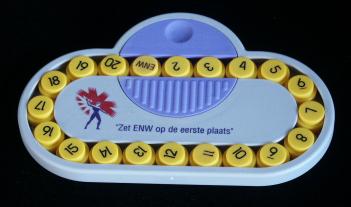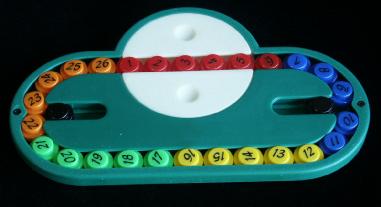The Topspin puzzle is by Binary Arts (now called ThinkFun), but is also sold as No. Crunch under
their XEX brand name. It consists of 20 numbered round pieces in one long looped
track. You can slide all the pieces of the loop along. There is also a turntable
in the loop which can rotate any four adjacent pieces so that they will be in
reverse order. This in effect swaps two adjacent pieces and the two pieces
on either side of them. The aim is of course to place the pieces in numerical
order.
It was invented by Ferdinand Lammertink, and patented on 3 Oct 1989,
US 4,871,173.
If your browser supports JavaScript, then you can play Topspin by clicking
the link below:
There also exists a larger version from Taiwan with the catchy descriptive
name "Educational Logic Game". It has 26 pieces in the loop, which are
either numbered or have letters, and a turntable that can hold 5 pieces. It also
two small side-tracks which each have one black piece and room to hold one further piece
taken from the loop. If these sidetracks are used the puzzle becomes trivial, but in this
way it is supposed to be suitable as an educational toy for children learning to count or
form words. This puzzle was patented by Chiu-Huang Chang on 12 April 1997, US 5,622,368.
The number of positions of Topspin:
There are 20 distinct pieces, which can therefore be put in at most 20! possible
positions. All these are attainable, so there are 20!=2,432,902,008,176,640,000
distinct positions. If rotations of the loop are considered to be the same, then
there are only 19!=121,645,100,408,832,000 positions.
The number of positions of the "Educational Logic Game":
Ignoring the sidetracks, there are 26 distinct pieces which can therefore be put
in at most 26! possible positions. Without the sidetracks it is not possible to
achieve all of these because the even and odd numbered pieces will always remain
alternating, so there can really be at most 2·13!
2 positions.
However, the permutation parity of the even numbered pieces is equal to that of
the odd pieces, so this leaves only 13!
2 = 38,775,788,043,632,640,000
distinct positions. If rotations of the loop are considered to be the same, then
there are only 13!
2/26 = 1,491,376,463,216,640,000 positions.



